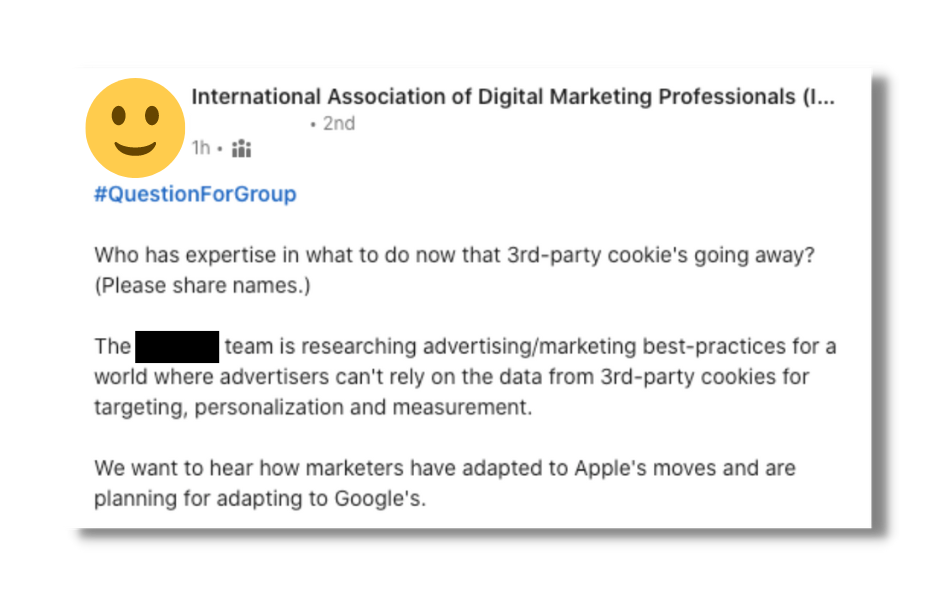For over two years, National Positions has sounded the alarm that third-party data would soon become a thing of the past. Were we wrong? Were we overcautious? Or perhaps we just saw the writing on the wall and knew the clock was ticking.
And now, the industry is finally taking notice.
Recently, a post on LinkedIn piqued our interest—not because it was a bad question but because it is being asked this late in the game.

Again, this is a fantastic question.
So let’s answer the question and go a bit further. Our team has been preemptively addressing this issue for nearly 24 months, so we know what works now, what is likely going to work down the road, and what you need to future-proof your campaigns.
First-Party Data Pivot
Perhaps the first and most direct way to combat the data being lost (due to Google’s dissolution of cookies and Apple’s iOS updates) is to focus on first-party data rather than third-party data.
Here is a quick recap of the difference. Most ad marketplaces like Facebook and Google Ads rely on third-party data. The keywords, audiences, and interests you choose to make your campaigns more valuable are filtered through third-party data algorithms and then served up to those searching or scrolling.

First-party data is collected via your in-house CRM or ecommerce purchasing platform like Shopify. A customer fills out their info to purchase from your website, and this data is now essentially owned by your company and can be used in the future. The customer information your brand already paid to acquire from marketing efforts is your first-party data. Only you have access to it, making this data worth its weight in gold.
You likely have already been collecting first-party data without even knowing it. The question now becomes…what do you do with it? We will get into this as we move along. But first things first, make sure you are collecting first-party data so you can leverage it moving forward.
Offline Conversion Tracking
Offline conversion tracking goes hand-in-hand with first-party data. Essentially, this is the tracking of actual sales conversion across your marketing channels, including those from organic search traffic, email, and paid advertising like Google Ads and Facebook.
Even though the data on paid ad platforms is becoming less valuable, the platforms themselves still hold immense power and are not going away anytime soon. So, we can use our own first-party data to enrich our current paid media performance.
Your offline (and first-party) conversion data can be offloaded and essentially “reinjected” into your current campaigns to make them smarter. When given better and more accurate data, the ad platform algorithms can use this data to better target the right kind of customers. The geographic, demographic, and interest-based data points specific to your customer base can still work for you.
However, you (and we) cannot rely on ad platforms to do the heavy data lifting anymore.
Accurate Conversion Attribution
You need to attribute where your conversions are coming from accurately. This means not just taking the ad platforms’ word for it.
Here is a dirty little secret that most ad platforms don’t want you to know. They don’t really know if what they track as a “conversion” can be attributed to their ad platform. The key word here is “attributed.”
Most ad marketplaces like Google Ads and Facebook default to a “last click” attribution model. Meaning that if the last touch before a purchase came from an ad, Facebook or Google will claim the credit. Even if your customer saw an ad, visited your website, responded to an email, etc., before clicking that last ad—credit goes to the last touchpoint standing.
Why does this matter? Let’s say you are running ads on Google and Facebook and spending $5k per month on each. You make 100 sales for the month. Google claims it drove 90 conversions, and Facebook claims it drove 90 conversions. Not only is this impossible (the math is not mathing), but how are you supposed to know which works better when everyone is claiming the credit for all these conversions?
All of this is to say that your team needs to be able to determine where these conversions are coming from while making sure they are lining up with your own first-party data conversions (kind of like balancing a checkbook).
Once you can accurately attribute where conversions are coming from—thanks to your first-party data—then you can proceed with scaling the highest-performing campaigns. (More on this subject later.)
Complete Data Ownership
The throughline in the preceding three subjects is that you own all of this data. Your first-party, offline, and conversion data is all data you can leverage in the future.
This ownership is at the heart of this entire discussion surrounding the ineffectiveness of third-party data moving forward. People don’t want their data haphazardly tracked and sold by corporate conglomerates like Google and Facebook.
At the same time, the vast majority of customers prefer their advertising messages to be tailored and personalized to them, meaning that there is a middle ground between using and abusing customers’ data.
It is also the reason that advertisers are going to be sweating in 2023 as cookies continue to crumble and Facebook keeps trying to tread water. By the way, if you don’t think Facebook advertisers are feeling the heat, check out Meta’s stock prices over the past few months.
At the end of the day, you need to own the data you are (ethically) collecting and, in turn, leveraging for future campaigns. If you own it, you don’t need to rely on third parties and their limited data reach anymore; you are able to move forward with far more clarity and freedom.
AdBeacon Does It All
How can you put all this data into one place? By using AdBeacon. AdBeacon is a new technology stack that National Positions has been using in tandem with our clients’ campaigns for several months, and so far, we’ve seen fantastic results.
AdBeacon can be used by anyone running Facebook and/or Google Ads. It streamlines conversion tracking, campaign optimization, first-party data tracking, and much more. We have heard that very soon, they are going to be releasing updates for TikTok and Amazon as well, which we can’t wait to test in Q4.
This platform allows us to see where success—via first-party data tracking—is coming from and attributes everything directly to campaigns and even specific ads. Our team can now compare the real conversion numbers against what Facebook or Google is reporting, so we know what to scale and when to scale it.
We know that all of the steps mentioned above can be time-consuming in and of themselves, so the fact that AdBeacon can do the heavy lifting helps us scale ROAS and lets us track customer journeys. The timing for AdBeacon’s arrival on the marketing scene is perfect.
If you have a chance, we highly recommend jumping on their 30-day trial while it lasts. Not to mention, it is a far more cost-effective option than other players in the market. You can find more information at www.AdBeacon.com.
Don’t Sweat It—Move Forward
As marketers (and business owners), we only have two options—to scream at the tech giants or to adapt. National Positions doesn’t have time to scream into the tech void, so we are going to keep adapting just as we have over the past (nearly) two decades.
Need help adapting to the choppy ad waters? We can do that too. Hop over to our contact us page and let us know what is impacting your ad campaign efforts and we can see about getting you back on track.

